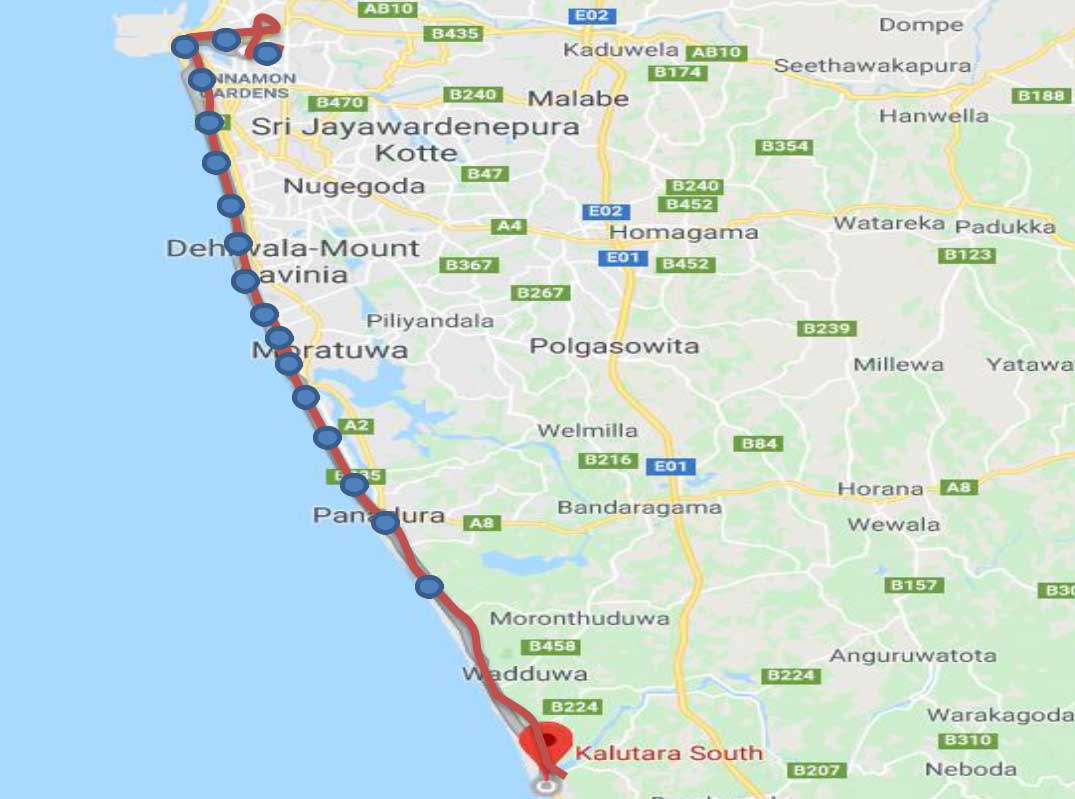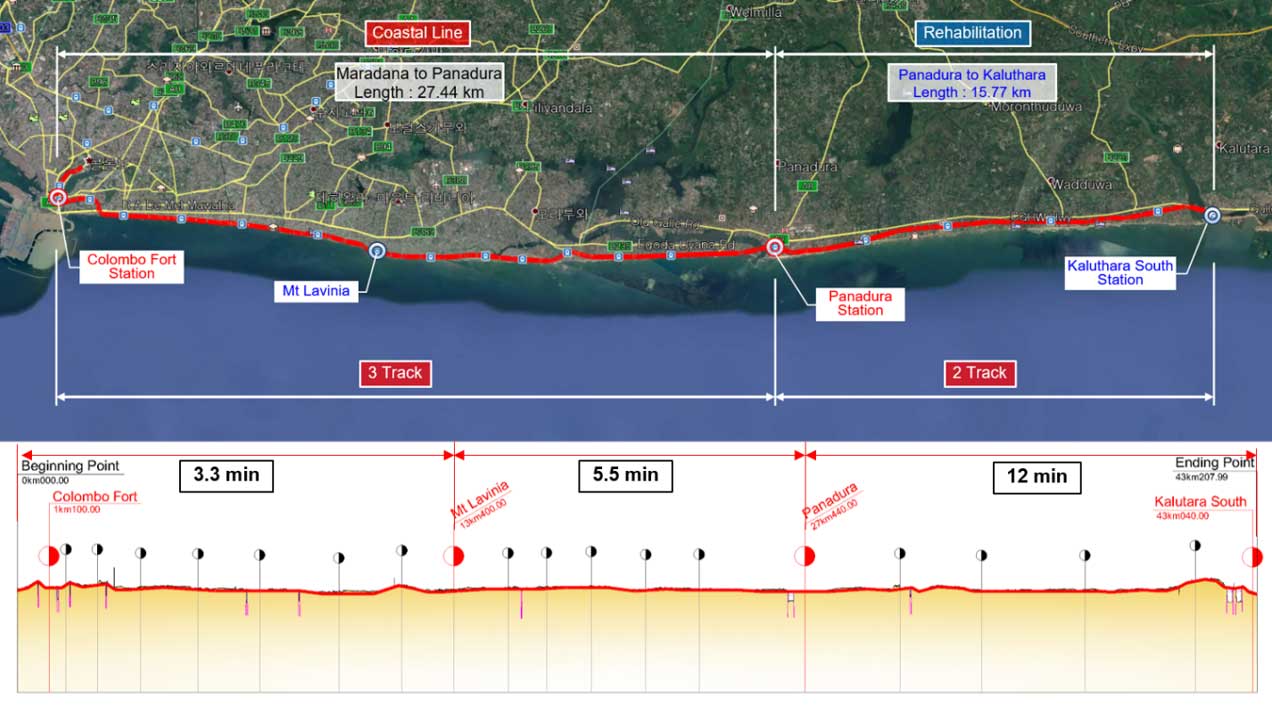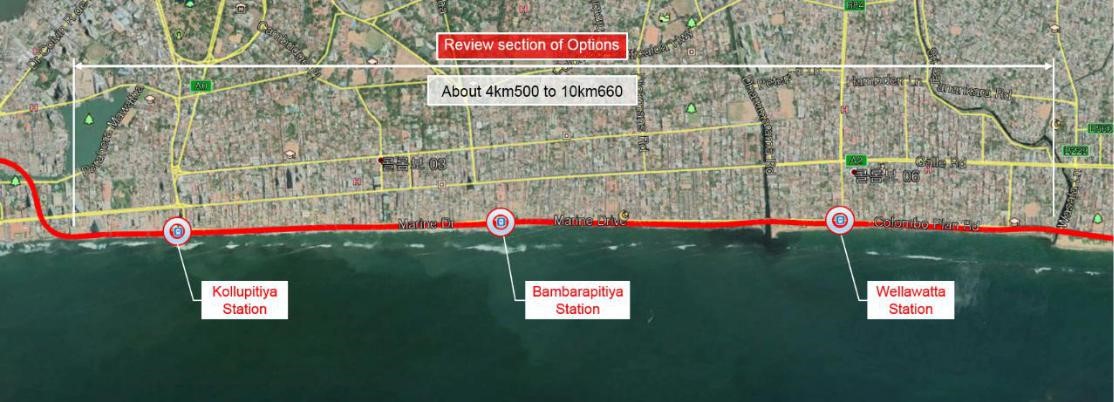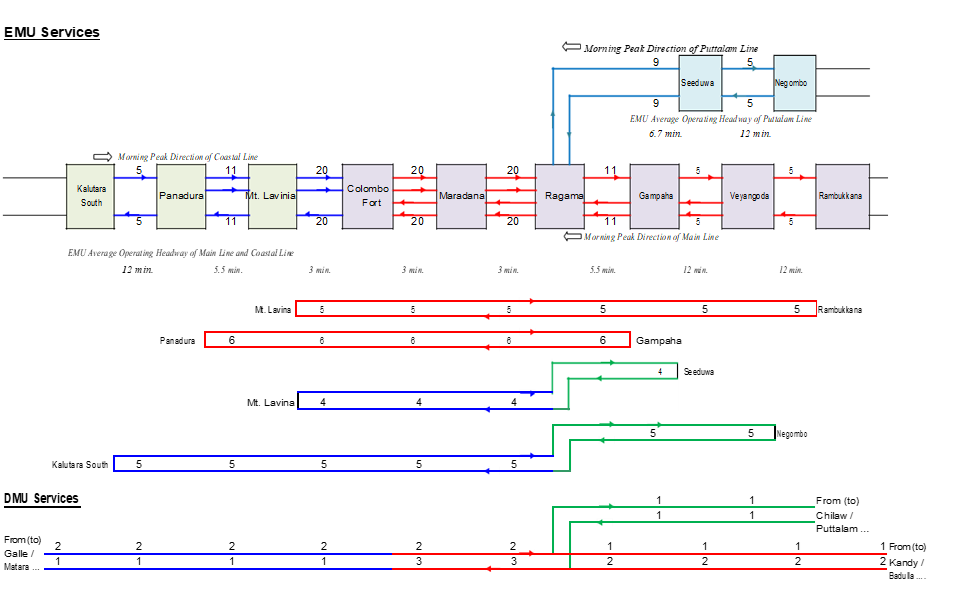Costal Line Development
The Coastal Line of Sri Lanka Railways is 187.0 km, from Colombo (Maradana) to Beliatte and runs right along the west coast of the country (only the end section from Matara to Beliatte deviates slightly from the coast).
Kaluthara South, which is considered as the end station of Colombo Suburban Area in the Coastal Line, is 43 km away from Maradana and the section from Colombo Fort to Kaluthara South is having two tracks. The estimated daily ridership in the Coastal Line is approximately 80,000 with majority of the suburban trains, serving morning peak period, starting from Kaluthara South and Panadura.
The line runs parallel to Galle Road, serving the same corridor and serves 40% of the total passengers in the Galle corridor to Colombo. Therefore, the Railway line runs along and through urban ceters such as Mount Lavinia, Moratuwa, Panadura, Kaluthara South, Aluthgama, Ambalangoda,Galle and Matara. The most popular Long Distance express trains in the Coastal Line are from Beliatte, Matara and Galle. At present, the number of trains in the Morning Peak includes 10 Colombo Commuter Trains and 3 Lond Distance Express Trains.
The improvement of railway in Sri Lanka can ease the traffic congestion, increase transport capacity, enhance the passenger convenience, serve better population distribution, gain commercial market share, and finally assist uniform economic development which will increase the GDP of Sri Lanka.

Costal Line
Travel Time comparison: by Bus and by Train
Demand for Costal Railway Line - Study Results
| Year | Number of Passengers to carry | Number of Trains operated | |||
|---|---|---|---|---|---|
| Daily Volume | Volume in Peak Hour peak direction | Daily Number of Trains | Trains in Peak Hour peak Direction | Headway (time between trains) | |
| 2018 | 170,000 | 18,000 | 74 per direction | 11 | 5.5 Mts |
| 2025 – After Development | 370,000 | 38,000 | 127 per direction | 15 | 4 Mts |
| 2035 – After Development | 440,000 | 46,000 | 168 per direction | 18 | 3.3 Mts |
Coastal Line Railway Alignment

Specific Issues in designing a solution for Coastal Line
In Kelani Valley Line Development, the solution addresses 08 specific issues which are not found in other Railway Lines in Sri Lanka. In Main Line development, we found only general issues.
But, in Coastal Line, the design must address some general and specific issues. As per the demand studies and to cater the demand for Coastal Line in 2025 and 2035, it is necessary to construct the third line from Colombo Fort to Panadura. The Consultancy Team and SLR decided to reserve a corridor for construction of fourth line.
- The Railway RoW is encroached : The railway corridor in the coastal line is narrow and is confined to the existing double track railway. In addition, the Railway RoW is heavility encroached in some sections such as Moratuwa and Rathmalana. When considering about the railway expansions (corridor for 04 track construction), there will be approximately 1072 relocations, of which 938 relocations will be from Colombo to Panadura. Majority of the encroachments will be in Rathmalana (323 relocations ) and in Maratuwa (431 relocations) areas.
- Interactions between Railway Project and Beach Nourishment Project : The section of the beach from Kollupitiya to Dehiwala (06km) will be developed for recreational activities by Beach Nourishment Project which is carried out as a Public-Private Partnership Project. Coastal Railway in this section hinders free access to the recreational project area.
- Interactions between Railway Project and Marine Drive Road Project : Marine Drive Road runs right along the Coastal Railway on the Land Side, hindering expansions of the Railway Line towards land side. The Road is now available from Kollupitiya to Dehiwala and will be extended to Panadura.
- Level Crossings : Considering the frequency of train operation for train speed of 120 kmph, it is desirable to eliminate level crossings where rail and road are at same level. As solutions, underpass or overpass (flyover) with road deviations can be considered. Private and rarely used level crossings which are unprotected will be closed and traffic will be diverted towards the nearest Flyover/underpass level crossing. There are 20 numbers of level crossings from Colombo Fort to Panadura section. The number of level crossings from Panadura to Kaluthara is 23.
- Insufficient Clear Height of Galle Road flyover at 3.3 km between Colombo Fort and Kollupitiya : The Flyover for Galle Road at 03.3 km between Colombo Fort and Kollupitiya has the clear height (height from Rail Level to bottom the flyover) of only 4.3m. The electrification require about 6.0 m clearance.
Coastal Line Railway Development Design
Considering the above issues and the passenger demand for Coastal Line in 2035, design of Coastal Line Railway is ongoing and will be complered in October 2020. Findings of the undermentioned studies are being used for the design.
- The Pre-Feasibility Study conducted by M/s. Egis International of France
- Coastal Line Feasibility Study conducted by M/s. Dohwa Engineering JV of Korea : 02 alternative for the Horizontal Alignment and 03 alternatives for Vertical Alignment have been considered in this study
The reader is requested to download and refer the undermentioned reports regarding Coastal Line Development
- Pre-Feasibility study report
- Coastal Line Final Feasibility study report
The other Design Reports related to Coastal Line have not been released yet.
Factors considered in selecting the solutions for the Coastal Line
- Implement the project in two phases, Colombo Fort to Panadura, Panadura to Kaluthara South.
- Colombo Fort to Panadura section is constructed as 03 tracks, and Panadura to Kaluthara South as 02 tracks (existing 02 tracks will be rehabilitated).
- All stations must have mutimodl features such as integration with bus operation and park and ride – this is to encourage modal shift from bus and car to rail
- Travel time needs to be optimised – this is also to attract passengers
- The universal access to and from trains ,and within the trains ,need to be provided.
- Aviod disturbance to vehicular traffic at level crossings – this is to avoid traffic congestion
- Land acquisition to be minimised – this is to avoid disturbance to lives of people and to save GoSL funds which will be used for payment of compansation.
- Relocations to be done as per National Involuntary Resettlement Policy (NIRP) and ADB Safeguard Policy There will be approximately 1072 relocations, of which 938 relocations will be from Colombo to Panadura. Majority of the encroachments will be in Rathmalana (323 relocations ) and in Maratuwa (431 relocations) areas. Environmental issues such as Niose and Vibration need to be mitigated
- Cost of the construction must be minimised – this is to select the solution with minimum cost
- Insufficient Clear Height of Galle Road flyover at 3.3 km between Colombo Fort and Kollupitiya – There are 03 such bridges from Maradana to Kollupitiya which are to be lifted by about 1.0 m to get clearance for Catenary system of Electrified Railway. This was discussed with the Highways Ministry and decided to create a separate small scale project jointly by RDA and Railways. This has been informed ERD to find financing for this purpose.
- Interactions between Railway Project and Beach Nourishment Project – Discussions have been held with the Beach Nourishment Project and it has been decided to develop coastal line railway as “at grade” and Beach Nourishment Project will allocate space for 04 railway lines from Kollupitiya to Dehiwala from the reclaimed area. The Railway Stations will be developed by the Beach Nourishment Project and the stations will provide access to recreational areas (beach side) from Marine Drive. For this purpose, the existing Down Line (Railway Line near Marine Drive) will be removed and will be laid on the Beach side by the Beach Nourishment Project at a latter stage
Solution for Horizontal Alignment
Two options were considered (1). Existing Alignment, (2). Alignment towards sea from the existing alignment in the reclaimed area of the Beach Nourishment Project. Option-2 was proposed by the consultants of Beach Nourishment Project. However, option-2 was not considered because the railway development and beach deveopment will not happen in synchronism and hence, both projects will be affected if option -2 is selected.
The Maradana to Kaluthara south is 43km, with 20 stations located in the section with average length of 2.15 km between stations. When considering about the passenger demand and number of trains to be operated by SLR in 2035, the track capacity needs to be improved as follows.
| Section | Number of Tracks | |
| Existing | Future | |
| Colombo Fort - Panadura | 2 | 3 |
| Panadura –Kaluthara south | 2 | 02 (Rehabilitation) |
When providing additional tracks, coastal line alignment up to Dehiwala Canal section needs to be widened towards sea side. Hence, railway embankment construction needs some reclamation in beach area.
From Maradana to Kaluthara south of the Coastal Line, there are 85 curve sections. Additional line is added up to Panadura and there are 17 locations from Colombo Fort to Kaluthara South where curve radius is less than 620m (min. curve radius to achieve 100km/h speed). Also, many residential houses and buildings located in and around of those locations. Practically, enlarging curve radius more than 620m needs additional land acquisition, house demolition etc. When considering about the reduction in travel time, straightening of railway tracks and achieving higher speeds is not that effective, because of the railway stations at close proximity. Therefore, the new Coastal Line Railway has been straightened and designed as far as possible, within existing ROW to minimize land acquisition and house demolition. However, some curves (Ex: Pinwatte), have been straightened by acquiring lands because the houses are not disturbed.
Solution for Vertical Alignment
Three Vertical alignment options for the section from 4.5 km to 10.6 km of the Coastal line were considered.

They were, Option 1 : At grade, Option 2 : Elevated and Option 3 : Underground.
Option-2 and 3 were proposed by the consultants of Beach Nourishment Project. It was studied whether the financial burden of these options could be accomodated by the Beach Nourishment Project. Therefore, after several discussions, it was decided to drop options - 2 and 3 because, the additional expenditure will have an impact on the financial viability of the Beach Nourishment Project.
However, in order to facilitate implementation of both projects in the future, the following way forward has been decided.
- Railway construction will be an “at grade’ design.
- Beach Nourishment Project will provide a corridor of construction of three additional railway lines in the section from 4.5 km to 10.6 km.
- The FS&DD consultants of the Colombo Suburban Railway Project will design the railway in this section as ‘At Grade’ with three railway lines in the section from Colombo Fort to Panadua.
- Later, along with the design and construction of Beach Nourishment Project, two additional railway Lines will be constructed by that project along the same railway alignment.
- After handing over the two new lines for the Railway Operation, the railway line (existing down line) near Marine Drive will be removed to provide space for Beach Nourishment Project to construct Railway Stations and ramp sections.
Train Operation
When designing the Train Operation Plan, the undermentioned factors have been considered.
- The outcome of Demand Modeling and passenger demand for Coastal Line Railway by 2025 and 2035
- Avoid congestion and train delays, caused by terminating all Coastal Line train operations at Maradana station.
- It is assumed that Main Line and Coastal Line developments will be completed simultaneously. But, if Coastal Line or Main Line projects would be delayed, SLR may implement an alternative Operation Plan as an initial step. The guidance required to implement such a plan has been given in the Feasibility Study Report
- Situation when electrification would be implemented in the Main Line first and then implement in Coastal Line or vice versa.
- Operation of EMUs and DMUs simultaneously along same section of tracks.
- Simultaneous operation of Express, Limited Stop, All Stop and Freight trains
Track availability for operation
| Section | Number of Tracks | |
| Existing | Future | |
| Colombo Fort - Panadura | 2 | 3 |
| Panadura –Kaluthara south | 2 | 02 (Rehabilitation) |
Journey Time and Commercial Speed : This is given in the following table. The Travel Times and Speeds of the current oprtation have been given for comparison.
| Section | Comparison of New/Current Operation | All-stop EMU trains | Express EMU trains | ||
| Journey Time | Timetabled Speed | Journey Time | Timetabled Speed | ||
| (minutes) | (km/h) | (minutes) | (km/h) | ||
| Colombo Fort –Panadura | New operation | 34 | 46.5 | 23 | 68.7 |
| Current Operation | 53 | 29.8 | 37 | 42.6 | |
| Colombo Fort –Kalutara South | New operation | 50 | 50.3 | 34 | 74 |
| Current Operation | 79 | 32 | 58 | 43.4 | |
The Scheduled Journey Time is based on three factors, Technical Journey Time (usually obtained through simulations) between stations, Regulation (Recovery) Time and Dwelling (Stopping time at stations) time.
Train Operation to cater the Passenger Demand in Peak Hour in Peak Direction and to solve congestion in Colombo Fort and Maradana areas
In order to avoid seriously congested rail traffic in Colombo Fort and Maradana, the direct operation of EMU services between Main, Puttalam and Coastal Line has been considered. This is called loop operation between railway lines. This will help us to cater Passenger Demand in Main Line and In Coastal Line with limited number of Rolling Stock. The number of train services during peak periods in peak direction has been planned as shown below.
Train Operation to cater the Passenger Demand in Peak Hour in Peak Direction and to solve congestion in Colombo Fort and Maradana areas (shown under Main Line Development too because the designed operation is a loop operation covering both main line and Coastal Line).
| Trainset Type | Origin – Destination Section | 2025 | 2035 | ||
| For Peak Periods | For Off-peak Periods | For Peak Periods | For Off-peak Periods | ||
| EMU Services | Mt. Lavinia – Rambukkana | 5 | 3 | 5 | 3 |
| Panadura – Gampaha | 5 | 3 | 6 | 3 | |
| Mt. Lavinia – Seeduwa | 2 | 2 | 4 | 3 | |
| Kalutara South – Negombo | 5 | 2 | 5 | 3 | |
| Sub-Total EMU Services | 17 | 10 | 20 | 12 | |
| Average Operating Headway between Colombo Fort and Ragama | 3.5 min. | 6 min. | 3 min. | 5 min. | |
| DMU Services | Rambukkana – Colombo Fort | 2 | 1 | 2 | 1 |
| Negombo – Colombo Fort | 1 | 1 | 1 | 1 | |
| Kalutara South – Maradana | 2 | 1 | 2 | 1 | |
| Sub-Total DMU Services | 5 | 3 | 5 | 3 | |
| Average Operating Headway between Colombo Fort and Ragama | 20 min. | 30 min. | 20 min. | 30 min. | |
Train Operation Plan with Track Utilisation and Loop Operation between Railway Lines :
Train services are planned as shown in Figure below for morning peak periods in 2035 with the direct travelling services for Main Line, Coastal Line and Puttalam Line. For evening peak periods, train services are the same as for morning peak periods, with the direction reversed.

